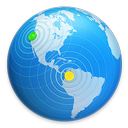
Change your server’s IP address with macOS Server
The Server app displays your server’s IP address, which you can change in the Network pane of System Preferences. If you change the IP address, you may also need to update the DNS server for your network, and users’ computers may need to be reconfigured. If your server has multiple network interfaces, you can find and change each one’s IP address.
Changing your server’s IP address can have significant unexpected consequences, depending on the services your server provides.
Find your server’s IP address
To find your server’s IP address, select the server in the Server app
 sidebar, then click Overview.
sidebar, then click Overview.
The numeric IP address appears below the Networks heading, to the right of the network interface name. If your server has multiple interfaces, each is listed.
Change your server’s IP address
Select the server in the Server app
 sidebar, then click Overview.
sidebar, then click Overview.Click Edit next to Host Name.
In the Change Host Name assistant, you only need to make changes in the Connecting to your Server pane.
Click Edit next to Network Address.
Select the network service listed on the left (for example, Ethernet 1), then enter an IP address on the right.
You can’t change the IP address if the Configure IPv4 setting is Using DHCP. In this case, the DHCP server for your network assigns an IP address to your server. The DHCP server should be configured to assign your server the same IP address all the time. This feature is called static mapping or DHCP reservations. If you have an Internet router, it’s probably your DHCP server, and you should see its documentation for instructions.
If the IP address can’t be edited, change the Configure IPv4 setting to Manually or “Using DHCP with manual address.”
Click Apply, then click Finish.
After you change your server’s IP address, the DNS server for your network must be updated so that your server’s host name points to the new IP address. Also, a reverse lookup of the new IP address must point to your server’s host name.
If your DNS service is provided by your ISP or another server on your network, ask your ISP or the DNS server administrator to update your server’s DNS records. If your server provides its own DNS service, you can use the Server app to update it.
Changing your server’s IP address may disrupt the connections of users’ computers that have macOS installed. If this happens, users need to remove your server from their list of network account servers and then add it back. For more information, search Mac Help for “Join your Mac to a network account server.”
After you change the server’s IP address, an alert about it appears in the Server app’s Alerts pane. The alert contains a button you can click to update services to use the new network configuration. When you click the button, the Server app runs the changeip command-line tool. This automated resolution updates services managed by the Server app.